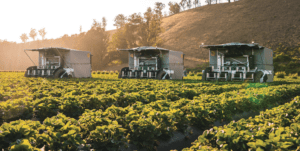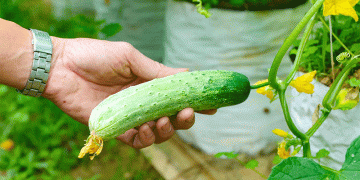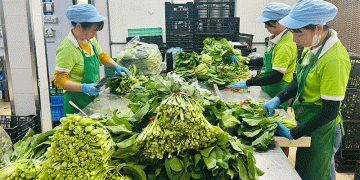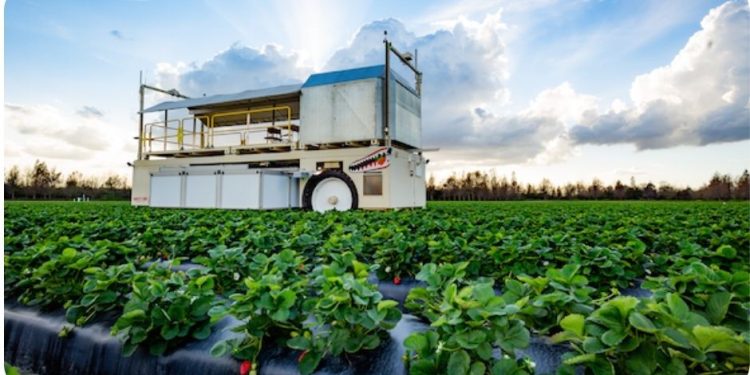Automated strawberry harvests are taking place in select fields of California and Florida, as the robots become more commercial and less experimental.
The California Polytechnical University’s Strawberry Center in late August conducted a virtual field day with updates on equipment. It wasn’t just about the robots; presentations from researchers included plans for improved lygus bug vacuums and tools for punching transplant holes into plastic bed covers.
“Now, more than ever, strawberry growers are looking toward technology for solutions, said researcher John Lin, who heads up the robotics projects for the Strawberry Center.
The field day included updates of strawberry harvester projects from three firms: Advanced.farm, Harvest CROO and Traptic. Here are some updates on those three harvesters, in the words of their developers:
Harvest CROO
After several years of development, the investment group led by Gary Wishnatzki of Wish Farms anticipates its Harvest CROO robot will soon participate in commercial harvests.
“Our expectation is we will be commercially picking fresh berries this coming season with the one prototype we have,” Wishnatzki told Vegetable Growers News. “We did do some commercial picking for processed berries last season, on a small scale, but our expectation is we’ll be doing more widespread use this coming season.”
If the harvest goes well, the group plans to build a small fleet of the machines for the following year and begin commercializing the product, he said.
He’s the co-founder and managing partner of Harvest CROO Robotics, which now includes investments from brands across the industry, such as Driscoll’s, Naturipe and the packaging products company Sonoco. Wishnaki said investors represent roughly 70% of the U.S. strawberry industry, in addition to private equity.
“It’s a collaborative effort,” he said. The Harvest CROO has been field-tested on G&D Farms, a 600-acre Florida strawberry farm owned by Wishnatzki.
There are some differentiations between the Harvest CROO and other ventures, Wishnatzki said. First, the Harvest CROO, like Traptic and Advanced.farm, are built to harvest conventional strawberry fields that are standard for U.S. growers, while other developers are exploring robotics alongside modified growing systems such as elevated beds.
“Those systems only work if you’re able to sell berries for a much higher price than we’re currently able to sell berries for,” Wishnatzki said. Second, while some groups are describing their projects as “harvest aids,” his team is attempting to match the thoroughness of humans.
“We’re attempting to do it where we clear as many berries as human harvesters,” Wishnatzki said. The Harvest CROO is being developed alongside a system for sorting out the bad berries. “Somebody asked me early on, when will I declare a success for this, and I said, ‘When we have parity with humans.’ And we currently see a path to that right now. With these corrective actions we’re doing this summer, I believe we’ll have parity with humans, so that’s a major claim, once we’re able to do that. We’re not quite there, yet, but we do see the path to … being there by next season.”
Built for Florida- and northern-California-style beds, Harvest CROO runs four beds wide.
“We’re currently able to clear a plant in about 8 seconds – that’s clearing at least three berries off of the plant,” Wishnatzki said. “And the robot itself has a total of 16 robotic heads … we’re clearing 16 plants in about 8 seconds.
Growers interested in the program are encouraged to visit harvestcroo.com.
Advanced.farm
Advanced.farm co-founder Kyle Cobb provided the following written update to Vegetable Growers News:
“As you know, we closed a $7.5 million Series A round in August 2019 with Yamaha and Kubota as lead investors, joining our previous seed-stage investors, Catapult Ventures and Impact Ventures. At that point, we were riding tailwinds from a successful season of picking with our ‘T6’ prototype, a semi-autonomous tractor with six robotic arms designed specifically for in-soil strawberry harvesting. With the T6, we became the first company to sell robotically-picked strawberries into the fresh market retail channel.

“Over the past year, we have built on this momentum to become a leader in robotic harvesting. We deployed our newly designed TX robotic strawberry harvesters across all three major growing regions in California (Oxnard, Santa Maria and Salinas/Watsonville), and we worked with industry-leading grower-shippers such as GoodFarms. Working closely with our grower partners, we picked hundreds of pounds of fruit every day in a season when labor supply was particularly top-of-mind. We will continue to work with GoodFarms and others in the coming year, optimizing field operations and continuing to improve our technical performance (yes, there are still some bugs to work out!).
“We know that our success is predicated on growers’ success. Our equipment is designed to be practical – we consider compliance with food safety protocols, ease of training new operators and ease of maintenance – and it is designed to be affordable. We have a flexible business model that allows growers to lease equipment (with our team providing maintenance and support) or choose a pay-as-you-go, piece-rate model. We continue to approach the problems we face with humility, working shoulder-to-shoulder alongside our grower partners to make improvements as fast as we can to bring a product to market at scale soon.
“One of the aspects of our work that we are particularly excited about is our advanced.jobs initiative, which outlines the two main ways we are working with our grower partners to make positive change to the farm workforce: 1) by building robots to tackle the hardest tasks facing humans today, and 2) by training the farm workforce with the skills needed to support operations of the next generation of farm equipment. Growers are welcome to read more about this, and our other guiding principles, on our website, www.advanced.farm.
“We regularly host demos in the field, and would welcome any interested growers to email us at info@advanced.farm.”
Traptic
Another company invited to the field day was Traptic, whose investors include Homebrew Ventures, K9 Ventures and Sinovation Ventures, according to Traptic’s website.
Traptic co-founder and CEO Lewis Anderson said in a short presentation during the field day that the system includes a patented gripper, an intelligent vision system and a durable robotic environment.
Traptic’s robot is a machine of some experience, he added.
“We’ve demonstrated that this system together is capable of picking berries at very high quality,” Anderson said. “We’re into our fifth year of field operations, and most importantly, we’ve been running every day for the last 1.5 years of that. We’ve demonstrated the ability to run all day, every day, for long periods of time. We’re out picking berries continuously. We’ve tested in every time of year, every field condition, We’ve tested different plant varieties, every geographic area. We’ve tested in early season, midseason, late season. We were out in Oxnard through late May. We’ve been out in Watsonville through late September. And most importantly, we’ve found a way to harvest every berry on the ranch for same or lower cost than what you’re paying now, and in a way that increases your yield overall.”
Anderson added that the group is expanding the robots’ availability.
“We are starting large-scale deployments very soon, so if you’re a grower, come talk to us about doing a commercial deployment,” he said. “We’re getting a lot of interest and would like to fit you in. Come talk to me about how we can harvest every berry on your ranch, for fixed costs per tray.”
Growers are encouraged to contact the company at Lewis@Traptic.com or 760-845-8171, he said.
— Stephen Kloosterman, associate editor
































